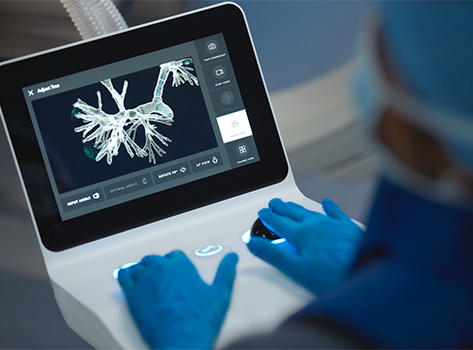Lung cancer is the second most common cancer, and more people die of it each year in the U.S. than any other cancer. Traditionally, lung cancer treatment has been challenging because diagnosis often came after symptoms began, when the disease had already spread to other parts of the body.
Three critical advancements — in diagnostics, intervention and treatment — offer new hope by changing the outcomes for many patients.
Ion Robotic Bronchoscopy Is Reaching New Places
With an ultrathin and extremely maneuverable catheter, new bronchoscopy technology called Ion helps surgeons reach small lesions anywhere in the lungs for a minimally invasive biopsy.
“This robotic technology uses a flexible catheter, allowing us to biopsy previously difficult-to-reach nodules in the periphery of the lungs with greater precision and stability,” says Bhavi Patel, MD, an interventional pulmonologist at Atlantic Health System.
“Minimally invasive robotic procedures like this one improve diagnostic accuracy with fewer risks, supporting early lung cancer detection and staging with a single minimally invasive procedure,” Dr. Patel explains. “We’re excited to add Ion robotic bronchoscopy to our system’s suite of services.”
Overlook Medical Center Among First in the World to Use Cytalux®
Atlantic Health System’s Overlook Medical Center was among the first in the world to use an innovative new medication called Cytalux® to detect lung cancer, even at its earliest stages. Cancer patients being evaluated for a lung nodule, which may indicate the presence of cancer, get Cytalux via IV infusion before surgery.
Cytalux is made up of fluorescent folic acid. It accumulates in cancer cells but quickly passes through noncancerous cells. In real time, the surgeon can see the cancerous tissue more easily, offering an effective way to detect lesions that may not have been visible to surgeons in the past. This method is especially helpful in patients with small, otherwise difficult-to-see lesions.
“Cytalux is changing the way we detect and treat lung cancer,” says Federico Steiner, MD, a thoracic surgeon at Atlantic Health System. “Cytalux lets us intervene very early with a high degree of confidence that we got all of the malignant cells, rather than observing a patient for months while cancer cells continue to grow. This is one of the many testaments of our commitment to bring the most advanced and innovative solutions in care to our patients.”
With few negative side effects, Cytalux is the only fluorescent imaging technology approved by the U.S. Food and Drug Administration. The ability to detect and remove these lesions is crucial in preventing cancer from spreading and offers a better chance of long-term survival for patients.
New PEF Energy Platform Combined with Ion Robotics Is a Big Win for Patients
Morristown Medical Center is the first hospital in New Jersey to treat advanced lung cancer by combining the new Aliya™ Pulsed Electric Field (PEF) Energy Platform with Ion robotic bronchoscopy.
The FDA-approved Aliya uses high-voltage electrical pulses to ablate soft tissue tumors, offering a lower-temperature alternative to traditional thermal ablation for removing or destroying abnormal tissue. Unlike traditional methods that rely on extreme heat, Aliya uses a lower temperature, minimizing damage to surrounding tissue, reducing inflammation and lowering the risk of lung collapse and bleeding.
“By combining the technology of the Aliya PEF Energy Platform with bronchoscopy, patients now have access to a less invasive, yet highly effective treatment for advanced lung cancer,” says Mark Widmann, MD, a thoracic surgical oncologist at Atlantic Health System. “This is particularly crucial for those who aren’t candidates for surgery or radiation, allowing a more personalized approach to care.”
Pioneering Continued Advancements in Cancer Care
These advancements allow physicians at Atlantic Health System to leverage new solutions in the fight against cancer. Early detection allows for early intervention and more effective treatments, thus greatly advancing our efforts to increase disease-free survival rates for patients.
“This type of innovation is important to achieve longer survival rates,” says Dr. Steiner. “We don’t want to be thinking about survival in terms of months. I want to see patients living cancer-free with a high quality of life 10-15 years from now.”
Be proactive about health
To stay safe and healthy, it's good to have a primary care provider who knows and understands your health history and wellness goals.









